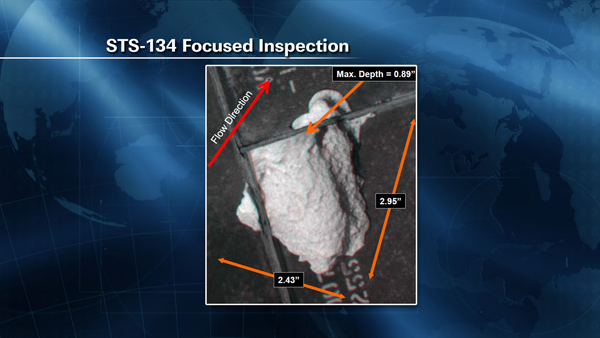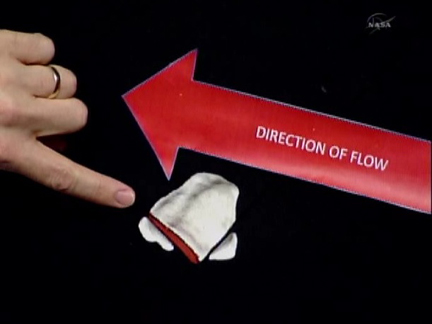Analysis shows damaged heat shield tile no threat to re-entry (UPDATED)
Editor's note...
CBS News
KENNEDY SPACE CENTER, FL--The shuttle Endeavour's crew used an instrumented boom on the ship's robot arm Saturday to carry out a close-up, focused inspection of a damaged heat shield tile on the belly of the orbiter. By late afternoon, analysts concluded the damage posed no threat to the orbiter and NASA's Mission Management Team cleared the ship for re-entry as is.
"So all good results all the way around," said MMT Chairman LeRoy Cain. "Ultimately, their recommendation to the MMT was that we clear this area. In accepting that recommendation, we're essentially clearing the vehicle for re-entry at this point. There were no dissenting opinions, no alternate opinions, the entire team was pretty much on board with the assessments that were done."
NASA managers were optimistic that would be the case, based on an analysis of long-range telephoto views shot during Endeavour's final approach to the station Wednesday, but the focused inspection was ordered Friday to make absolutely sure.
The inspection work began after midnight when the space station's robot arm was used to pull Endeavour's heat shield inspection boom, or OBSS, out of the ship's cargo bay for hand off to the shuttle's 50-foot-long arm. Pilot Gregory Johnson, overseeing a series of computerized maneuvers, then positioned the arm under the shuttle's right side for close-up photos and laser scans.
The imagery and laser scans showed the damage site measured 2.43 inches by 2.95 inches with a maximum depth of .89 inches. Cain said the analysis showed the aluminum structure below the damage site would experience maximum temperatures of around 219 degrees Fahrenheit during re-entry, well below the 350-degree safety limit.
"With this data, to include the laser data that the team was able to acquire from the focused inspection, the analyses teams went back and essentially what they did is verify how much tile is still in the cavity," Cain said. "Because, of course, it's more important what remains than it is what's gone, per se. What we're interested in is protecting the structure underneath the tile and the associated systems."
And based on that analysis, "it was clearly OK," he said.
To make doubly sure they were on solid ground, analysts created a three-dimensional representation of the damage that had the uniform shape required for computer modeling. As such, the computer model assumed more damage than was seen in the actual gouge, "and in running that analysis, they determined we still cleared with plenty of margin."
The astronauts went to bed no knowing the Damage Assessment Team results, but Cain said they knew engineers were optimistic. With the damage site cleared for entry as is, the astronauts will have one less worry as they prepare for a second spacewalk Sunday to add ammonia coolant to a space station solar array.
Here is a timeline of the crew's remaining schedule for flight day six (in EDT and mission elapsed time; includes revision E of the NASA television schedule; best viewed with fixed-width font):
- Posted at 12:58 AM EDT, 05/21/11: Astronauts begin work to inspect damaged tile
- Updated at 05:05 AM EDT, 05/21/11: Gouged heat shield tile inspected
- Updated at 02:20 PM EDT, 05/21/11: MMT briefing delayed to 5 p.m. EDT
- Updated at 04:20 PM EDT, 05/21/11: MMT briefing moved up to 4:30 p.m. EDT
- Updated at 05:40 PM EDT, 05/21/11: MMT determines damaged tile no threat to safe re-entry
CBS News
KENNEDY SPACE CENTER, FL--The shuttle Endeavour's crew used an instrumented boom on the ship's robot arm Saturday to carry out a close-up, focused inspection of a damaged heat shield tile on the belly of the orbiter. By late afternoon, analysts concluded the damage posed no threat to the orbiter and NASA's Mission Management Team cleared the ship for re-entry as is.
"So all good results all the way around," said MMT Chairman LeRoy Cain. "Ultimately, their recommendation to the MMT was that we clear this area. In accepting that recommendation, we're essentially clearing the vehicle for re-entry at this point. There were no dissenting opinions, no alternate opinions, the entire team was pretty much on board with the assessments that were done."
 |
| A high-resolution photo of a damaged heat shield tile taken during a so-called "focused" inspection Saturday showed the gouge was no threat to the shuttle Endeavour. (Credit: NASA TV) |
NASA managers were optimistic that would be the case, based on an analysis of long-range telephoto views shot during Endeavour's final approach to the station Wednesday, but the focused inspection was ordered Friday to make absolutely sure.
The inspection work began after midnight when the space station's robot arm was used to pull Endeavour's heat shield inspection boom, or OBSS, out of the ship's cargo bay for hand off to the shuttle's 50-foot-long arm. Pilot Gregory Johnson, overseeing a series of computerized maneuvers, then positioned the arm under the shuttle's right side for close-up photos and laser scans.
The imagery and laser scans showed the damage site measured 2.43 inches by 2.95 inches with a maximum depth of .89 inches. Cain said the analysis showed the aluminum structure below the damage site would experience maximum temperatures of around 219 degrees Fahrenheit during re-entry, well below the 350-degree safety limit.
 |
| MMT Chairman LeRoy Cain points to a model of a damaged tile that was fabricated based on data collected Saturday. (Credit: NASA) |
And based on that analysis, "it was clearly OK," he said.
To make doubly sure they were on solid ground, analysts created a three-dimensional representation of the damage that had the uniform shape required for computer modeling. As such, the computer model assumed more damage than was seen in the actual gouge, "and in running that analysis, they determined we still cleared with plenty of margin."
The astronauts went to bed no knowing the Damage Assessment Team results, but Cain said they knew engineers were optimistic. With the damage site cleared for entry as is, the astronauts will have one less worry as they prepare for a second spacewalk Sunday to add ammonia coolant to a space station solar array.
Here is a timeline of the crew's remaining schedule for flight day six (in EDT and mission elapsed time; includes revision E of the NASA television schedule; best viewed with fixed-width font):
DATE/EDT...DD...HH...MM...SS...EVENT
05/21
12:56 PM...05...04...00...00...Garan sleep begins
01:26 PM...05...04...30...00...STS crew sleep begins
02:00 PM...05...05...04...00...Replay of PAO event with Pope Benedict XVI
03:16 PM...05...06...20...00...ISS evening planning conference
04:00 PM...05...07...04...00...Mission Management Team briefing on NTV
05:31 PM...05...08...35...00...ISS crew sleep begins
06:45 PM...05...09...49...00...Flight director update on NTV
08:45 PM...05...11...49...00...Flight director update replay on NTV
09:26 PM...05...12...30...00...STS crew/Garan wakeup